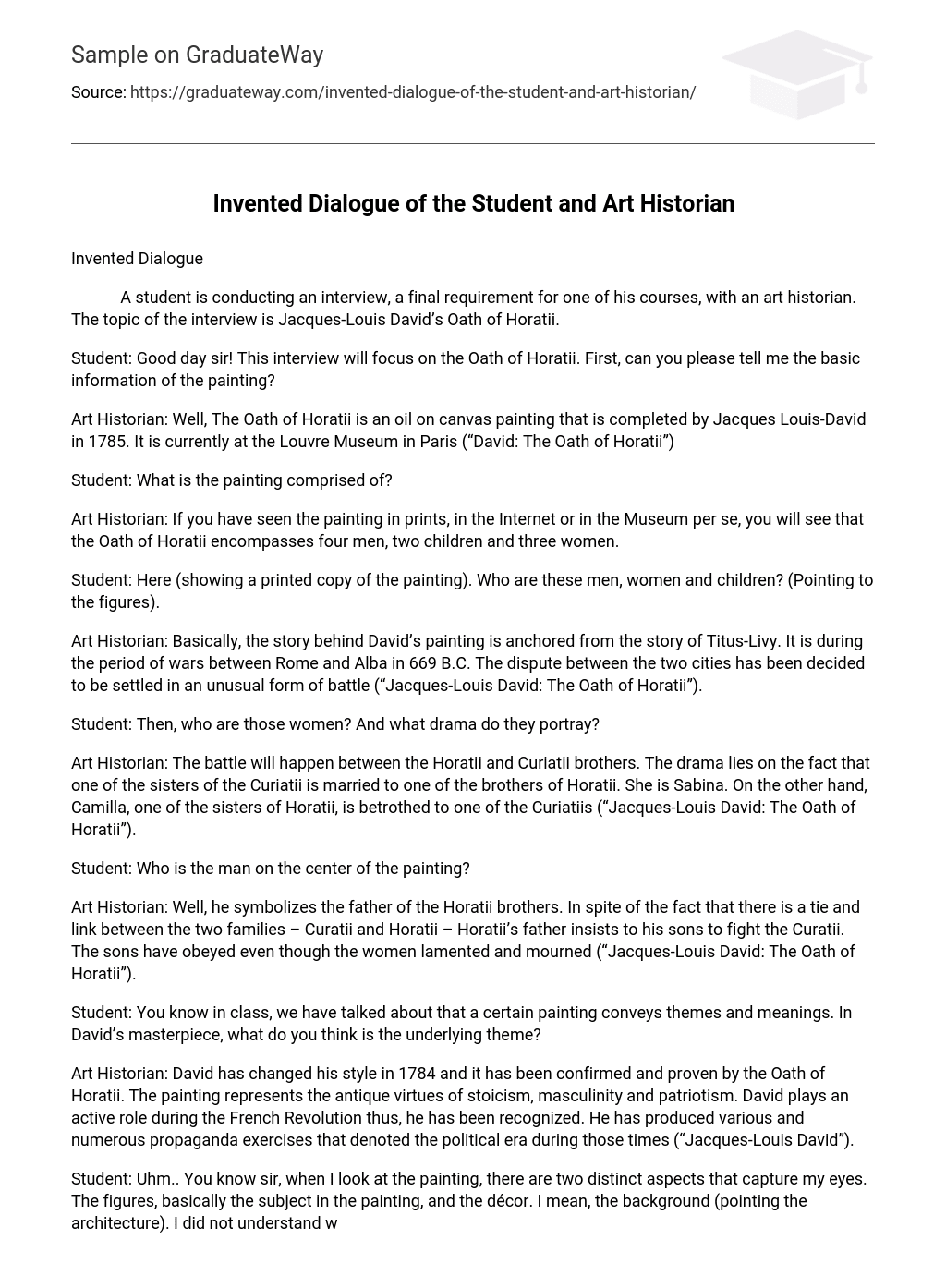Invented Dialogue
A student is conducting an interview, a final requirement for one of his courses, with an art historian. The topic of the interview is Jacques-Louis David’s Oath of Horatii.
Student: Good day sir! This interview will focus on the Oath of Horatii. First, can you please tell me the basic information of the painting?
Art Historian: Well, The Oath of Horatii is an oil on canvas painting that is completed by Jacques Louis-David in 1785. It is currently at the Louvre Museum in Paris (“David: The Oath of Horatii”)
Student: What is the painting comprised of?
Art Historian: If you have seen the painting in prints, in the Internet or in the Museum per se, you will see that the Oath of Horatii encompasses four men, two children and three women.
Student: Here (showing a printed copy of the painting). Who are these men, women and children? (Pointing to the figures).
Art Historian: Basically, the story behind David’s painting is anchored from the story of Titus-Livy. It is during the period of wars between Rome and Alba in 669 B.C. The dispute between the two cities has been decided to be settled in an unusual form of battle (“Jacques-Louis David: The Oath of Horatii”).
Student: Then, who are those women? And what drama do they portray?
Art Historian: The battle will happen between the Horatii and Curiatii brothers. The drama lies on the fact that one of the sisters of the Curiatii is married to one of the brothers of Horatii. She is Sabina. On the other hand, Camilla, one of the sisters of Horatii, is betrothed to one of the Curiatiis (“Jacques-Louis David: The Oath of Horatii”).
Student: Who is the man on the center of the painting?
Art Historian: Well, he symbolizes the father of the Horatii brothers. In spite of the fact that there is a tie and link between the two families – Curatii and Horatii – Horatii’s father insists to his sons to fight the Curatii. The sons have obeyed even though the women lamented and mourned (“Jacques-Louis David: The Oath of Horatii”).
Student: You know in class, we have talked about that a certain painting conveys themes and meanings. In David’s masterpiece, what do you think is the underlying theme?
Art Historian: David has changed his style in 1784 and it has been confirmed and proven by the Oath of Horatii. The painting represents the antique virtues of stoicism, masculinity and patriotism. David plays an active role during the French Revolution thus, he has been recognized. He has produced various and numerous propaganda exercises that denoted the political era during those times (“Jacques-Louis David”).
Student: Uhm.. You know sir, when I look at the painting, there are two distinct aspects that capture my eyes. The figures, basically the subject in the painting, and the décor. I mean, the background (pointing the architecture). I did not understand why they have captured my attention but I know that David, definitely has done it for reason. Can you please explain it to me?
Art Historian: Yes. The painting certainly has that kind of effect, as if imposing to its spectators that it has two distinct features. First are the figures. It captures our eyes because there is repetition. Have you noticed that there are three groups and each of them possess different purpose (pointing the three figures on the printed copy)? In order to have an appeal to Horatius, the figure on the center, there must be a spontaneous act on its left side, which is indeed portrayed by the three brothers. They demonstrate the vigor of the oath; they uphold loudly and show their strength. On the other hand, its right side illustrates three lamenting women. The second feature that is striking on the painting is its décor. David has juxtaposed two art forms in the painting per se: painting and architecture. The background reveals an architectural space. There are massive columns and arches. Those three arches correspond to the brothers. So instead of making its setting on the outside, David chooses to depict it inside of an edifice (“Jacques-Louis David: The Oath of Horatii”).
Student: Why do you think so?
Art Historian: To add more on the drama. Look (pointing on the shadows); there are shadows in it which also implied that the scene is inside. These shadows (still pointing on them), leads and gives a result on the lighting appearance that the setting is on a brick-toned reflection. David’s arrangement of figures creates harmony of the colors. There is density in the figures. David has intended to paint The Oath of Horatii in that manner because he wants to proclaim a new neoclassical style and approach.
Student: Well, that sums up everything.
Art Historian: Anything else?
Student: None sir. The information that you have given me is enough. I greatly appreciate the time that you have given me. Thank you very much.
Art Historian: You are welcome.
Works Cited
“David: The Oath of Horatii.” n.d. 11 February 2009 <http://history.hanover.edu/courses/art/davhor.html>
“Jacques-Louis David.” n.d. Artchive. 11 February 2009 <http://www.artchive.com/artchive/D/david.html>
“Jacques-Louis David: The Oath of Horatii.” n.d. Neo-Classicism and French Revolution. 11 February 2009 < http://www.bc.edu/bc_org/avp/cas/his/CoreArt/art/neocl_dav_oath.html>





